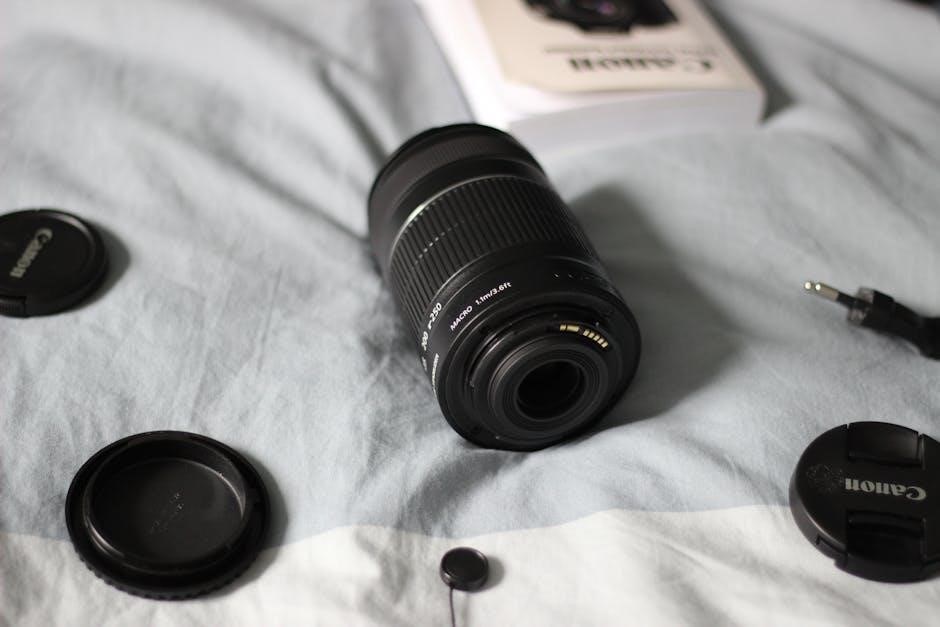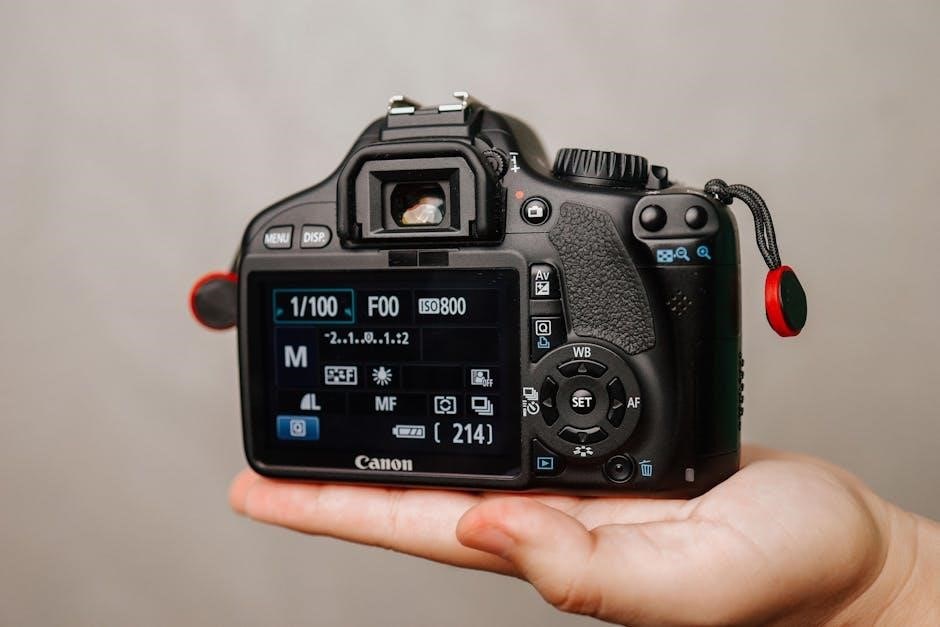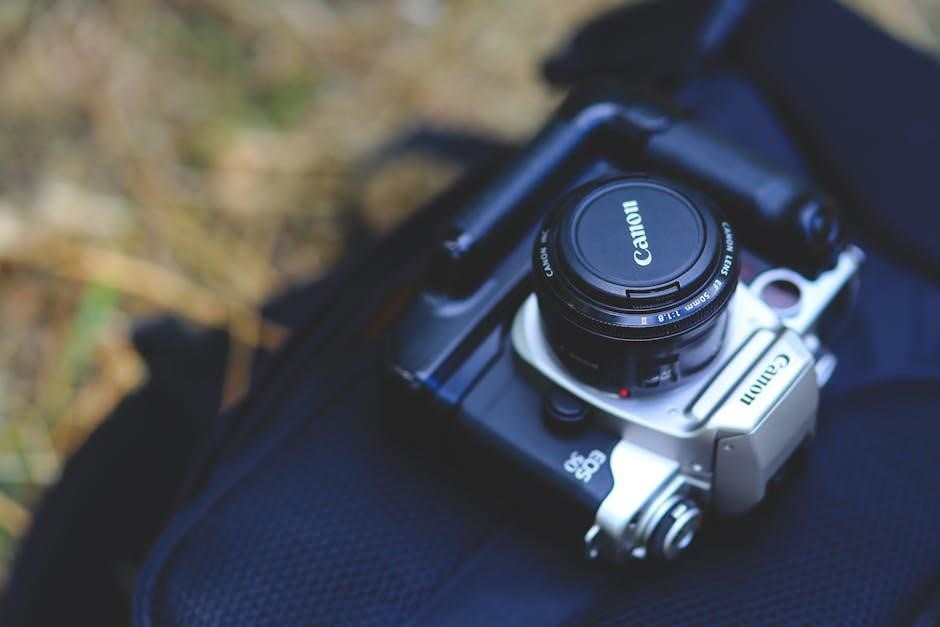Canon 7D User Manual: A Comprehensive Guide
Welcome to the ultimate resource for mastering your Canon EOS 7D! This guide serves as an in-depth exploration beyond the basic instruction manual, offering insights into the camera’s features and functionalities. Learn to harness its 18.0-megapixel sensor, Dual DIGIC 4 processors, and advanced autofocus system. Let’s unlock your camera’s capabilities!
The Canon EOS 7D, a high-performance digital SLR camera, has garnered significant attention for its advanced features and capabilities. Boasting an 18.0-megapixel CMOS sensor and Dual DIGIC 4 processors, the 7D delivers high-resolution images with exceptional detail and clarity. Designed for enthusiast and professional photographers alike, this camera offers a robust set of tools for capturing stunning photographs and videos. Its rapid 8 frames per second continuous shooting capability allows users to capture fast-action sequences with ease.
This comprehensive user manual aims to guide you through every aspect of the Canon 7D, from basic operation to advanced techniques. Whether you’re a seasoned photographer or just starting your journey, this guide will help you unlock the full potential of your camera. We’ll cover everything from understanding the camera’s controls and navigating the menu system to mastering advanced shooting modes and customizing settings to suit your specific needs.
Furthermore, this guide will delve into practical tips and tricks to enhance your photography skills and make the most of the Canon 7D’s capabilities; Get ready to embark on a journey of discovery and elevate your photographic endeavors with the Canon EOS 7D!
Key Features of the Canon 7D
The Canon EOS 7D is packed with features designed to enhance your photography experience. At its core, the 18.0-megapixel CMOS sensor captures images with impressive detail and clarity, while the Dual DIGIC 4 image processors ensure fast and efficient performance. The camera’s high-precision, 19-point autofocus system, with all cross-type points, allows for accurate and reliable focusing, even in challenging shooting conditions.
The 7D’s viewfinder offers approximately 100% coverage, providing a comprehensive view of the scene. It’s capable of shooting continuously at approximately 8 frames per second, making it ideal for capturing fast-action subjects. The Live View shooting mode allows you to compose your shots on the LCD screen, while the Full HD video recording capability enables you to create high-quality videos.
Other notable features include various Picture Style settings for image customization, a range of metering modes for accurate exposure, and custom functions for personalizing the camera’s operation. The Canon 7D’s robust build quality and intuitive design make it a reliable and versatile tool for photographers of all levels. These key features combine to deliver a powerful and rewarding photography experience.
Understanding the Camera’s Controls and Dials
Gaining proficiency with the Canon 7D begins with understanding its array of controls and dials. The top panel features the Mode Dial, offering quick access to shooting modes like Auto, Program, Aperture Priority, Shutter Priority, Manual, and Custom modes. The Main Dial, located near the shutter button, is used to adjust settings like aperture, shutter speed, and exposure compensation, depending on the selected shooting mode.
The Quick Control Dial on the camera’s rear provides another means to navigate menus and adjust settings efficiently. A joystick allows for quick selection of autofocus points. Dedicated buttons for ISO, metering mode, white balance, and AF mode enable direct adjustments without delving into the menu system.
The LCD screen displays essential shooting information, and its brightness can be adjusted for optimal visibility. Customizing button functions through the Custom Functions menu can tailor the camera to your specific shooting style. Familiarizing yourself with these controls empowers you to make swift and informed decisions while shooting, ultimately leading to better results. Mastering these controls is crucial for unlocking the full potential of your Canon 7D.
Navigating the Menu System
The Canon 7D’s menu system is the central hub for customizing camera settings and accessing advanced features. Pressing the “Menu” button on the camera’s rear displays a series of tabs, each dedicated to a specific category like shooting settings, playback options, setup functions, and custom functions.
Within the shooting settings, you can adjust image quality, ISO speed, white balance, Picture Style, and more. The playback menu allows you to review, protect, rotate, and delete images. The setup menu contains options for formatting memory cards, adjusting LCD brightness, setting the date and time, and configuring power-saving settings.

The Custom Functions menu is where you can fine-tune the camera’s behavior to match your personal preferences. Here, you can customize button functions, adjust autofocus behavior, and configure exposure settings. Navigating the menu system is made easy by the Quick Control Dial and joystick, allowing for swift scrolling and selection of options. Utilizing the menu system is essential for maximizing the Canon 7D’s versatility and tailoring it to your unique shooting style. Understanding the menu layout and options empowers you to take full control of your camera’s performance.
Basic Shooting Modes: Auto, Program, and Creative Auto
The Canon 7D offers several basic shooting modes designed to cater to photographers of all skill levels. The “Auto” mode is the most straightforward, where the camera automatically selects all settings for optimal image capture in various situations. This mode is perfect for beginners or when quick snapshots are needed without manual adjustments.
The “Program (P)” mode provides more control while still automating some aspects. The camera sets the aperture and shutter speed, but you can adjust other settings like ISO, white balance, and exposure compensation. This mode allows for creative flexibility while maintaining ease of use.
The “Creative Auto (CA)” mode is designed to bridge the gap between full auto and more advanced modes. It simplifies complex settings into user-friendly options, such as adjusting background blur or image brightness. This mode is ideal for users who want to experiment with different effects without delving into manual settings. Each of these modes offers a different level of control, allowing you to gradually explore the camera’s capabilities and develop your photographic skills. Understanding these modes is crucial for effectively capturing images in various scenarios.
Advanced Shooting Modes: Aperture Priority, Shutter Priority, and Manual
The Canon 7D’s advanced shooting modes offer experienced photographers full creative control over their images. Aperture Priority (Av) allows you to set the aperture while the camera automatically selects the shutter speed. This mode is excellent for controlling depth of field, creating shallow focus portraits or landscapes with extensive sharpness.
Shutter Priority (Tv) enables you to set the shutter speed, with the camera adjusting the aperture accordingly. Use this mode to freeze motion with fast shutter speeds or create motion blur with slower speeds, ideal for sports or artistic effects.
Manual (M) mode provides complete control over both aperture and shutter speed. You adjust both settings independently, using the camera’s light meter as a guide for proper exposure. This mode is essential for challenging lighting conditions or when aiming for specific creative effects that require precise settings. Mastering these modes unlocks the full potential of your Canon 7D, allowing you to capture images exactly as you envision them, regardless of the shooting environment.
Focusing System: AF Modes and Area Selection
The Canon 7D boasts a sophisticated 19-point all cross-type autofocus (AF) system, enabling precise and rapid focusing across a wide area. Understanding its AF modes and area selection options is crucial for capturing sharp images in various shooting scenarios. The 7D offers several AF modes: One-Shot AF for stationary subjects, AI Servo AF for moving subjects, and AI Focus AF, which automatically switches between the two.
For AF area selection, you can choose from Single-point AF, where you manually select one of the 19 AF points; AF point expansion, which uses surrounding points to assist focusing; Zone AF, which groups AF points into zones; and 19-point automatic selection AF, where the camera chooses the AF points. Mastering these settings allows you to precisely control where the camera focuses, ensuring sharp results whether you’re shooting portraits, sports, or wildlife. Experiment with different combinations to find what works best for your subject and shooting style.
Metering Modes and Exposure Compensation
The Canon 7D employs a sophisticated metering system to evaluate the light in a scene and determine the optimal exposure settings. Understanding its metering modes and how to use exposure compensation is essential for achieving well-exposed images. The 7D offers four metering modes: Evaluative metering, which analyzes the entire scene; Partial metering, which measures light from a smaller area in the center of the frame; Spot metering, which measures light from a very small area; and Center-weighted average metering, which emphasizes the center of the frame.
Exposure compensation allows you to override the camera’s metering and brighten or darken the image. This is particularly useful in situations where the metering system is fooled by bright or dark subjects. By dialing in positive or negative exposure compensation, you can ensure that your images are properly exposed. Experiment with different metering modes and exposure compensation to achieve the desired look in your photos. Mastering these tools will significantly improve your exposure accuracy.
Image Quality Settings: Resolution, RAW vs. JPEG

The Canon 7D offers various image quality settings that impact the resolution and file format of your photographs. Understanding these settings is crucial for optimizing image quality and managing storage space. Resolution refers to the number of pixels in an image, with higher resolutions resulting in larger file sizes and more detail. The 7D allows you to choose from several resolution options, including Large, Medium, and Small, each with different pixel dimensions.
RAW and JPEG are two primary file formats for storing images. JPEG is a compressed format that reduces file size but sacrifices some image quality. RAW, on the other hand, is an uncompressed format that retains all the data captured by the sensor, providing greater flexibility for editing. Shooting in RAW allows you to adjust white balance, exposure, and other settings without degrading image quality. However, RAW files are larger and require specialized software to process. Choose the appropriate image quality settings based on your shooting needs and post-processing workflow to achieve the best results.
Custom Functions and Personalization
The Canon 7D provides a wealth of custom functions that allow you to personalize the camera to your specific shooting style and preferences. These custom functions enable you to modify various aspects of the camera’s operation, from autofocus behavior to button assignments. For example, you can customize the function of the SET button or reassign the AE/FE lock button to perform a different task. Additionally, you can fine-tune the autofocus system to optimize its performance for different shooting scenarios.
Furthermore, the 7D allows you to create and save custom shooting modes, enabling you to quickly access your preferred settings for specific situations. By exploring and experimenting with the custom functions, you can tailor the camera to your individual needs and enhance your overall shooting experience. This level of personalization empowers you to work more efficiently and capture images that reflect your unique creative vision. Take the time to delve into these settings and unlock the full potential of your Canon 7D.
Using Live View and Video Recording
The Canon 7D offers a Live View mode, allowing you to compose your shots on the LCD screen instead of the viewfinder. This is particularly useful for macro photography, low-angle shots, or when using manual focus. Live View also provides a real-time preview of exposure settings, enabling you to fine-tune your image before capturing it. The 7D also excels in video recording, offering Full HD (1080p) video capabilities. You can adjust various settings like frame rate and resolution to suit your specific needs. The camera also allows for manual control over exposure and audio levels during video recording.
When using Live View or recording video, it’s crucial to understand the different autofocus modes available. You can choose between Quick Mode, Live Mode, and Face Detection Live Mode, each offering different focusing characteristics. Experiment with these modes to find the one that works best for your shooting style. The 7D’s video capabilities make it a versatile tool for both photographers and videographers. This facilitates the achievement of a professional level.

Troubleshooting Common Issues
Even with a robust camera like the Canon 7D, users may encounter occasional issues. One common problem is error messages appearing on the LCD screen. These messages often indicate problems with the memory card, lens, or battery. Always ensure your memory card is compatible and properly inserted. Check the lens contacts for dirt or debris, and make sure your battery is fully charged. Another frequent concern is blurry images. This could be due to slow shutter speeds, camera shake, or incorrect focus. Increase your shutter speed, use a tripod, or adjust your autofocus settings.
If your images appear overexposed or underexposed, review your metering mode and exposure compensation settings. Also, if you are finding that your 7D is not performing to its original functionality, it may be time to update the camera’s firmware. Software updates often fix glitches and can help keep your camera running smoothly. By systematically addressing these common issues, you can ensure a smooth shooting experience.

Downloading and Updating Firmware and Software
Keeping your Canon 7D’s firmware and software up to date is essential for optimal performance. Firmware updates often include bug fixes, performance improvements, and new features. To begin, visit the Canon support website and navigate to the EOS 7D download section. Ensure you select the correct operating system (Windows or macOS) and download the latest firmware version. Carefully read the instructions provided by Canon before proceeding with the update.
After downloading the firmware, you’ll typically need to copy it to a formatted memory card. Insert the card into your camera and access the firmware update option in the camera’s menu. Follow the on-screen prompts to complete the update process. It’s crucial to maintain a stable power source throughout the update to prevent interruptions. In addition to firmware, ensure you have the latest versions of Canon’s software, such as Digital Photo Professional, for image editing and management. Regular updates ensure compatibility, stability and access to the newest features.


